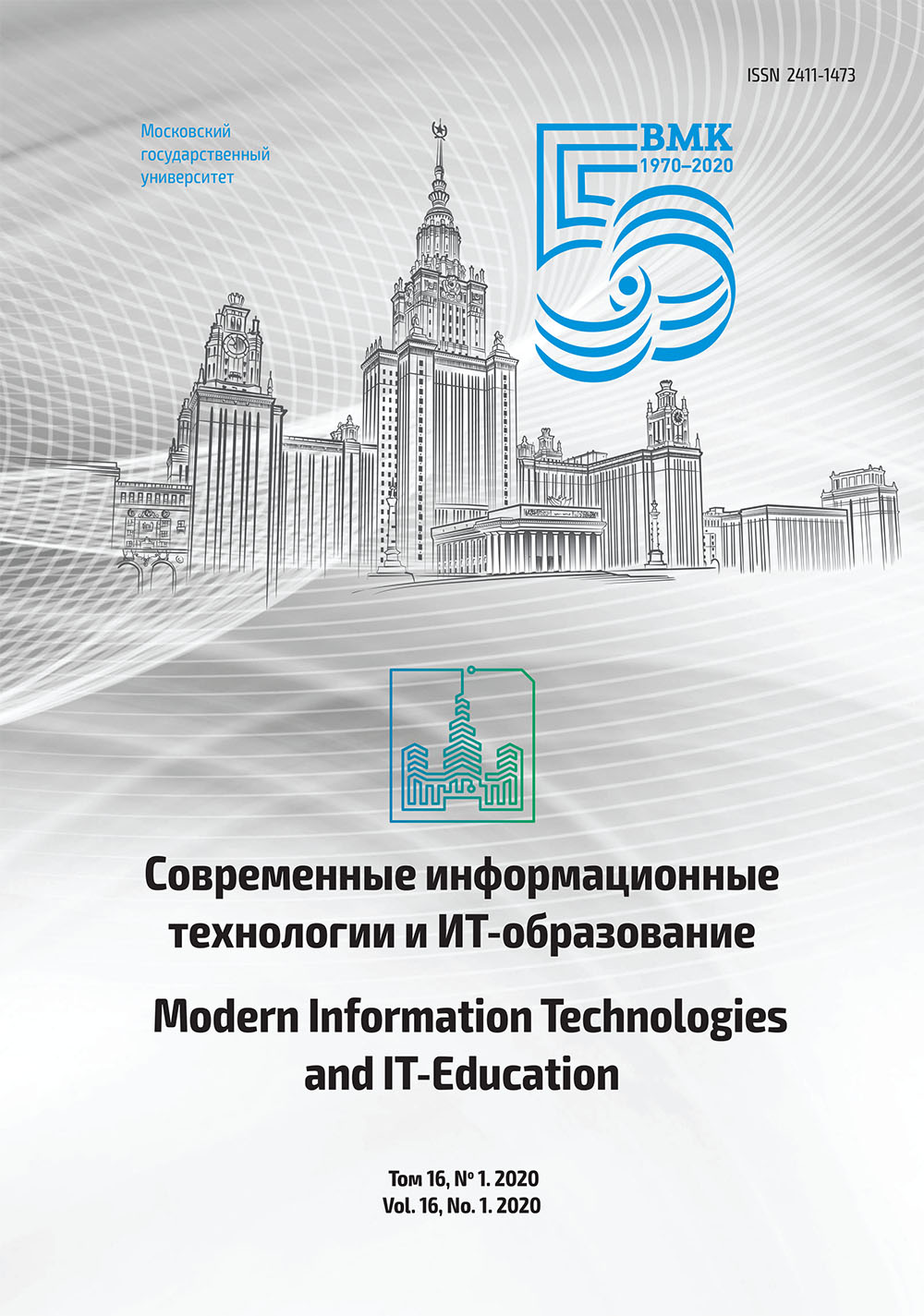Ограниченные алгоритмы приближенного поиска при обнаружении знаний
Аннотация
Обнаружение знаний в области больших данных является одним из наиболее важных приложений вычислительной техники сегодня. Поиск является неотъемлемой частью всех таких процедур. Алгоритмы поиска должны быть чрезвычайно эффективными, но в то же время процедуры обнаружения знаний не должны давать слишком много ложных срабатываний или ложных отрицаний. Ложные срабатывания требуют последующей обработки, что снижает общую эффективность процедур обнаружения знаний, в то время как ложные отрицания снижают чувствительность таких процедур. Чтобы уменьшить количество ложноположительных и ложноотрицательных результатов, в этой статье предлагается применять ограниченные приближенные алгоритмы поиска. Краткий обзор теории поиска, точной и приблизительной, дается вначале, раскрывая основы алгоритмов приближенного поиска на основе динамического программирования и на основе бит-параллелизма без ограничений. Затем объясняется введение ограничений, специфичных для различных процедур обнаружения знаний, а также тонкостей различных приложений, таких как фильтрация спама, цифровая и сетевая экспертиза (разделение файлов, обнаружение вторжений в хосты и сети). Также обсуждаются преимущества и недостатки применения таких ограниченных алгоритмов поиска в процедурах обнаружения знаний. Намечено потенциальное применение в биоинформатике.
Литература
[2] Baeza-Yates R., Gonnet G.H. A new approach to text searching. Communications of the ACM. 1992; 35(10):74-82. (In Eng.) DOI: https://doi.org/10.1145/135239.135243
[3] Chitrakar A., Petrović S. Approximate search with constraints on indels with application in SPAM filtering. In: Proceedings of Norwegian Information Security Conference (NISK-2015),Ålesund, Norway; 2015. p. 22-33. Available at: https://ntnuopen.ntnu.no/ntnu-xmlui/handle/11250/2380987 (accessed 21.1.2020). (In Eng.).
[4] Knuth D.E., Morris Jr. J.H., Pratt V.R. Fast Pattern Matching in Strings. SIAM Journal on Computing. 1977; 6(2): 323-350. (In Eng.) DOI: https://doi.org/10.1137/0206024
[5] Boyer R.S., Moore J.S. A fast string searching algorithm. Communications of the ACM. 1977; 20(10):762-772. (In Eng.) DOI: https://doi.org/10.1145/359842.359859
[6] Horspool R. Practical Fast Searching in Strings. Software: Practice and Experience. 1980; 10(6):501-506. (In Eng.) DOI: https://doi.org/10.1002/spe.4380100608
[7] Sunday D.M. A very fast substring search algorithm. Communications of the ACM. 1990; 33(8):132-142. (In Eng.) DOI: https://doi.org/10.1145/79173.79184
[8] Crochemore M., Rytter W. Text algorithms. Oxford University Press, Inc., USA; 1994. (In Eng.).
[9] Navarro G., Raffinot M. Fast and flexible string matching by combining bit-parallelism and suffix automata. ACM Journal of Experimental Algorithmics. 2000; 5:4-es. (In Eng.) DOI: https://doi.org/10.1145/351827.384246
[10] Zhang Y., Liu P., Liu Y., Li A., Du C., Fan D. Attacking Pattern Matching Algorithms Based on the Gap between Average-Case and Worst-Case Complexity. Journal on Advances in Computer Network. 2013; 1(3):228-233. (In Eng.) DOI: https://doi.org/10.7763/JACN.2013.V1.45
[11] Sipser M. Introduction to the Theory of Computation, 2nd ed. Thomson, USA; 2006. (In Eng.).
[12] Levenshtein V. Binary Codes Capable of Correcting Deletions, Insertions and Reversals. Soviet Physics Doklady. 1966; 10(8):707-710. (In Eng.).
[13] Wagner R.A., Fischer M.J. The String-to-String Correction Problem. Journal of the ACM. 1974; 21(1):168-173. (In Eng.) DOI: https://doi.org/10.1145/321796.321811
[14] Oommen B.J. Constrained String Editing. Information Sciences. 1986; 40(3):267-284. (In Eng.) DOI: https://doi.org/10.1016/0020-0255(86)90061-7
[15] Hyyrö H., Navarro G. Faster Bit-Parallel Approximate String Matching. In: A. Apostolico, M. Takeda (ed.) Combinatorial Pattern Matching. CPM 2002. Lecture Notes in Computer Science, vol.2373. Springer, Berlin, Heidelberg; 2002. p. 203-224. (In Eng.) DOI: https://doi.org/10.1007/3-540-45452-7_18
[16] Wu S., Manber U. Fast text searching: allowing errors. Communications of the ACM. 1992; 35(10):83-91. (In Eng.) DOI: https://doi.org/10.1145/135239.135244
[17] Golić J.Dj., Mihaljević M.J. A generalized correlation attack on a class of stream ciphers based on the Levenshtein distance. Journal of Cryptology. 1991; 3(3):201-212. (In Eng.) DOI: https://doi.org/10.1007/BF00196912
[18] Schryen G. Anti-SPAM Measures: Analysis and Design. Springer, Berlin, Heidelberg; 2007. (In Eng.) DOI: https://doi.org/10.1007/978-3-540-71750-8
[19] Chitrakar A., Petrović S. Constrained Row-Based Bit-Parallel Search in Intrusion Detection. In: Proceedings of Norwegian Information Security Conference (NISK-2016), Bergen, Norway; 2016. p. 68-79. Available at: https://ojs.bibsys.no/index.php/NISK/article/view/375 (accessed 21.1.2020). (In Eng.).
[20] Sagar S., Sidorova J. Sequence Retriever for Known, Discovered and User-Specified Molecular Fragments. In: M.S. Mohamad, M.P. Rocha, F. Fdez-Riverola, F.J. Domínguez Mayo, J.F. De Paz (ed.) 10th International Conference on Practical Applications of Computational Biology & Bioinformatics. PACBB 2016. Advances in Intelligent Systems and Computing, vol. 477. Springer, Cham; 2016. p. 51-58. (In Eng.) DOI: https://doi.org/10.1007/978-3-319-40126-3_6
[21] Sidorova J., Fernandez A., Cester J., Rallo R., Giralt F. Predicting Biodegradable Quality of Chemicals with the TGI+.3 Classifier. In: Proceeding (717) Artificial Intelligence and Applications / 718: Modelling, Identification, and Control - 2011.Innsbruck, Austria; 2011. p. 108-115. (In Eng.) DOI: https://doi.org/10.2316/P.2011.717-044
[22] Sidorova J., Anisimova M. NLP-inspired structural pattern recognition in chemical application. Pattern Recognition Letters. 2014; 45:11-16. (In Eng.) DOI: https://doi.org/10.1016/j.patrec.2014.2.12
[23] Sidorova, J., Garcia, J.-2015. Bridging from syntactic to statistical methods: Classification with automatically segmented features from sequences. Pattern Recognition. 2015; 48:3749-3756. (In Eng.) DOI: https://doi.org/10.1016/j.patcog.2015.5.1
[24] Dietterich T.G., Bakiri G. Solving multiclass learning problems via error-correcting output codes. Journal of Artificial Intelligence Research. 1995; 2:263-286. (In Eng.) DOI: https://doi.org/10.1613/jair.105
[25] Anand R., Mehrotra K., Mohan C.K., Ranka S. Efficient classification for multiclass problems using modular neural networks. IEEE Transactions on Neural Networks. 1995; 6(1):117-124. (In Eng.) DOI: https://doi.org/10.1109/72.363444

Это произведение доступно по лицензии Creative Commons «Attribution» («Атрибуция») 4.0 Всемирная.
Редакционная политика журнала основывается на традиционных этических принципах российской научной периодики и строится с учетом этических норм работы редакторов и издателей, закрепленных в Кодексе поведения и руководящих принципах наилучшей практики для редактора журнала (Code of Conduct and Best Practice Guidelines for Journal Editors) и Кодексе поведения для издателя журнала (Code of Conduct for Journal Publishers), разработанных Комитетом по публикационной этике - Committee on Publication Ethics (COPE). В процессе издательской деятельности редколлегия журнала руководствуется международными правилами охраны авторского права, нормами действующего законодательства РФ, международными издательскими стандартами и обязательной ссылке на первоисточник.
Журнал позволяет авторам сохранять авторское право без ограничений. Журнал позволяет авторам сохранить права на публикацию без ограничений.
Издательская политика в области авторского права и архивирования определяются «зеленым цветом» в базе данных SHERPA/RoMEO.
Все статьи распространяются на условиях лицензии Creative Commons «Attribution» («Атрибуция») 4.0 Всемирная, которая позволяет другим использовать, распространять, дополнять эту работу с обязательной ссылкой на оригинальную работу и публикацию в этом журналe.













